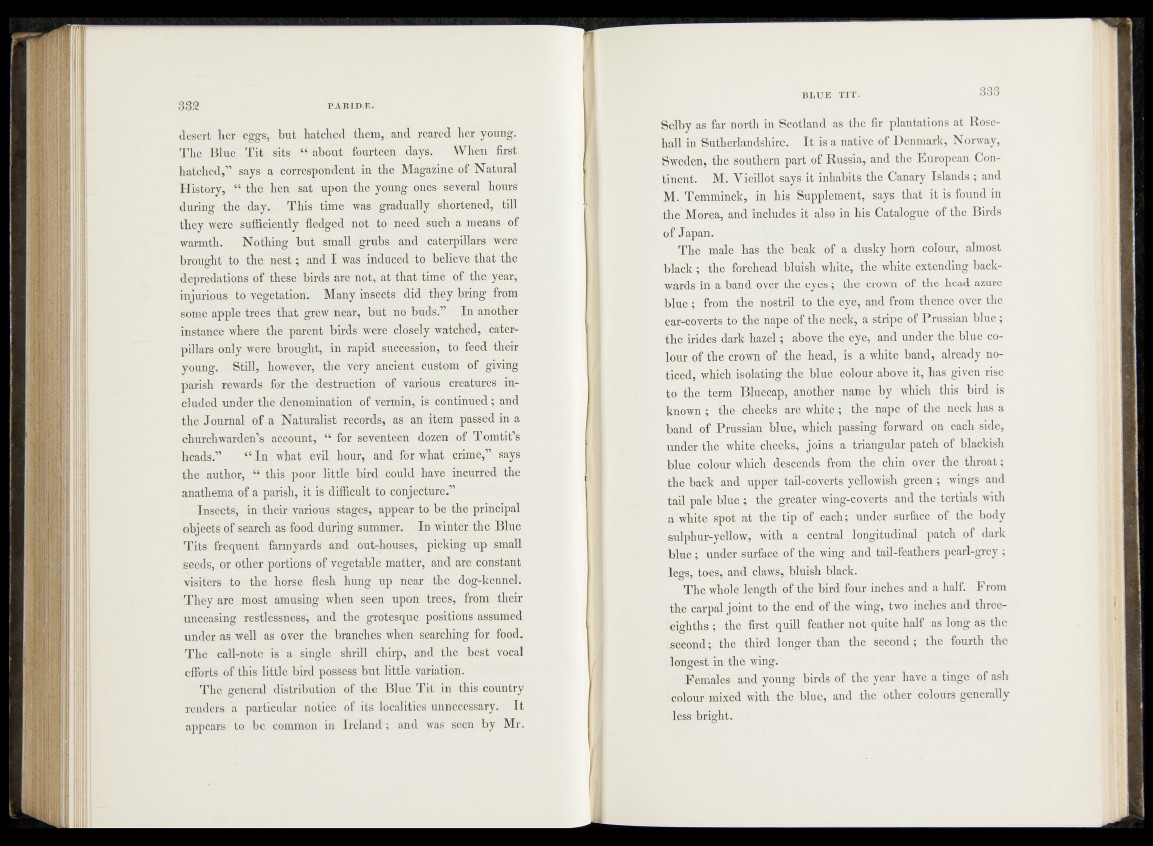
desert lier eggs, but hatched them, and reared her young.
The Blue Tit sits “ about fourteen days. When first
hatched,'11 says a correspondent in the Magazine of Natural
History, “ the hen sat upon the young ones several hours
during the day. This time was gradually shortened, till
they were sufficiently fledged not to need such a means of
warmth. Nothing but small grubs and caterpillars were
brought to the n e st; and I was induced to believe that the
depredations of these birds are not, at that time of the year,
injurious to vegetation. Many insects did they bring from
some apple trees that grew near, but no buds.11 In another
instance where the parent birds were closely watched, caterpillars
only were brought, in rapid succession, to feed their
young. Still, however, the very ancient custom of giving
parish rewards for the destruction of various creatures included
under the denomination of vermin, is continued; and
the Journal of a Naturalist records, as an item passed in a
churchwarden’s account, “ for seventeen dozen of Tomtit’s
heads.” “ In what evil hour, and for what crime,” says
the author, “ this poor little bird could have incurred the
anathema of a parish, it is difficult to conjecture.”
Insects, in their various stages, appear to be the principal
objects of search as food during summer. In winter the Blue
Tits frequent farmyards and out-houses, picking. up small
seeds, or other portions of vegetable matter, and are constant
visiters to the horse flesh hung up near the dog-kennel.
They are most amusing when seen upon trees, from their
unceasing restlessness, and the grotesque positions assumed
under as well as over the branches when searching for food.
The call-note is a single shrill chirp, and the best vocal
efforts of this little bird possess but little variation.
The general distribution of the Blue Tit in this country
renders a particular notice of its localities unnecessary. It
appears to be common in Ireland ; and was seen by Mr.
Selby as far north in Scotland as the fir plantations at Rose-
hall in Sutherlandshire. It is a native of Denmark, Norway,
Sweden, the southern part of Russia, and the European Continent.
M. Vieillot says it inhabits the Canary Islands ; and
M. Temminck, in his Supplement, says that it is found in
the Morea, and includes it also in his Catalogue of the Birds
of Japan.
The male has the beak of a dusky horn colour, almost
black ; the forehead bluish white, the white extending backwards
in a band over the eyes; the crown of the head azure
blue ; from the nostril to the eye, and from thence over the
ear-coverts to the nape of the neck, a stripe of Prussian blue;
the irides dark hazel; above the eye, and under the blue colour
of the crown of the head, is a white band, already noticed,
which isolating the blue colour above it, has given rise
to the term Bluecap, another name by which this bird is
known ; the cheeks are white ; the nape of the neck has a
band of Prussian blue, which passing forward on each side,
under the white cheeks, joins a triangular patch of blackish
blue colour which descends from the chin over the throat;
the back and upper tail-coverts yellowish green ; wings and
tail pale blue ; the greater wing-coverts and the tertials with
a white spot at the tip of each; under surface of the body
sulphur-yellow, with a central longitudinal patch of dark
blue ; under surface of the wing and tail-feathers pearl-grey ;
legs, toes, and claws, bluish black.
The whole length of the bird four inches and a half. From
the carpal joint to the end of the wing, two inches and three-
eighths ; the first quill feather not quite half as long as the
second; the third longer than the second; the fourth the
longest in the wing.
Females and young birds of the year have a tinge of ash
colour mixed with the blue, and the other colours generally
less bright.